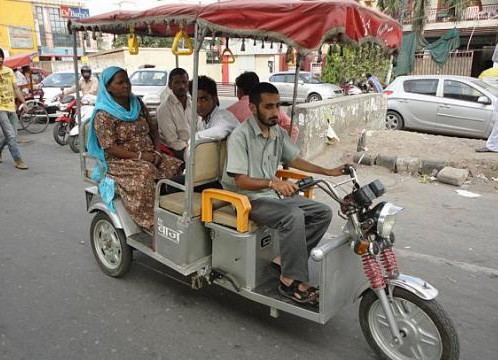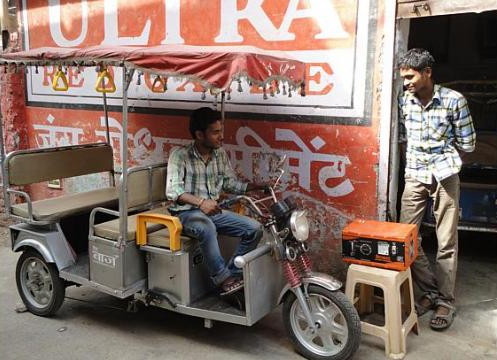Seventeen-year-old Mansi Sehgal gets into a three-wheel vehicle that looks a lot like Thailand’s tuk tuk, except that she is in West Delhi.
The silver vehicle powered by a battery is an electric rickshaw. It starts with a soft whirr even as the driver calls out for passengers heading within a 7 km radius. Two more passengers get on.
The rickshaw chugs along at a top speed of 25 kph, trying to keep out of the way of faster vehicles.
Cars, motorcycles and buses whizz by, some perilously close, but Sehgal, who would otherwise have taken the bus, is unfazed.
The e-rickshaw, as it is known, is another option in a city where the public transport system has failed to keep pace with a growing population.
“I like travelling in the electric rickshaw, even though I could have taken the bus for half the fare,” says Sehgal, who pays 10 rupees ($0.17), twice as much as the bus fare. “It’s worth it,” she says.
Any other kind of transport such as a taxi would cost at least 10 times more.
“On the bus, there are weird people and I don’t always feel safe, but in this, there are no such problems,” she says.
After traveling 6 kilometers in 15 minutes, Sehgal gets off and walks to the metro station.
The driver, who has earned 40 rupees from her and other passengers in the short stretch, makes a U-turn and joins a riot of green, red and blue e-rickshaws waiting at the roadside for passengers.
E-rickshaws were launched in Delhi in 2012.
The silver vehicle powered by a battery is an electric rickshaw. It starts with a soft whirr even as the driver calls out for passengers heading within a 7 km radius. Two more passengers get on.
The rickshaw chugs along at a top speed of 25 kph, trying to keep out of the way of faster vehicles.
Cars, motorcycles and buses whizz by, some perilously close, but Sehgal, who would otherwise have taken the bus, is unfazed.
The e-rickshaw, as it is known, is another option in a city where the public transport system has failed to keep pace with a growing population.
“I like travelling in the electric rickshaw, even though I could have taken the bus for half the fare,” says Sehgal, who pays 10 rupees ($0.17), twice as much as the bus fare. “It’s worth it,” she says.
Any other kind of transport such as a taxi would cost at least 10 times more.
“On the bus, there are weird people and I don’t always feel safe, but in this, there are no such problems,” she says.
After traveling 6 kilometers in 15 minutes, Sehgal gets off and walks to the metro station.
The driver, who has earned 40 rupees from her and other passengers in the short stretch, makes a U-turn and joins a riot of green, red and blue e-rickshaws waiting at the roadside for passengers.
E-rickshaws were launched in Delhi in 2012.

Now, more than 100,000 of these vehicles roam its streets, serving its residents but also adding to the capital city’s nightmare.
With poor enforcement of traffic rules, Delhi’s streets are chaotic. Last year, more than 1,800 people died in traffic accidents.
E-rickshaws have been involved in several accidents and, what’s worse, they are not regulated.
The Motor Vehicles Act does not recognize the battery-powered rickshaw as a motor vehicle because it does not exceed 30 kph.
So drivers do not need a license or registration papers and are not under any regulatory authority.
Not surprisingly, their numbers have grown quickly, along with the potential for trouble. Some drivers tinker with the design to increase the rickshaw’s speed.
Others have no driving experience at all and many overload the rickshaw meant to carry only four passengers.
The previous Congress-led government banned the sale of the vehicles in January in response to growing safety concerns.
An activist who considers them dangerous has petitioned the courts to have them banned altogether.
But the current Bharatiya Janata Party government has decided against taking the e-rickshaws off the road, opting instead for tighter regulation.
However, some road safety experts question whether the rickshaws, which are mostly made in China and assembled in India, are even structurally safe.
“If these vehicles are safe, we will support them. But they are not designed for safety. They have a disturbed center of gravity,” said S.P. Singh, senior fellow at Indian Federation of Transport Research and Training. “They have become a hazard.”
But the move was welcomed, unsurprisingly, by the Battery Rickshaw Welfare Association.
Its spokesman Rajiv Tuli said that once the new rules are in place, “there will be a registration process and every rickshaw will get a unique registration number. All the confusion will be sorted out.”
Those in the e-rickshaw industry also argue that the e-rickshaw is the future for India, which is heavily dependent on oil.
E-rickshaw drivers certainly prefer them to the cycle rickshaw.
Until six months ago, Chandrakant Kumar, 17, pedaled a cycle rickshaw for a living.
It was hard work in Delhi, where temperatures can rise to 45 degrees Celsius.
Now Kumar, who bought an e-rickshaw for 80,000 rupees with money provided by his parents, is earning enough to send some cash back to them.
“I save 700 to 800 rupees every month now. When I had the cycle rickshaw, I wouldn’t earn anything on some days.
“I used to get so tired every day. Now I work all day but I feel okay at the end of the day,” said Kumar, who now takes a long afternoon lunch break as he charges his vehicle.

Rajesh Taneja, a graduate who worked as a dietitian in a hospital previously, switched to driving an e-rickshaw in 2012.
His wife, who works in a private bank, was a little taken aback by his choice of profession.
“It took a little adjustment. She didn’t understand why I was doing this,” said Taneja.
“But she is okay with it. I have a regular source of income and I am my own boss. I don’t have other people telling me what to do.”
While the debate on the e-rickshaw rumbles on, 50-year-old civil servant Kapil Kumar continues taking it after work each night.
“I know people talk about safety, but where is the safety on roads anyway? The roads are so bad, why don’t they fix that first?” said Kumar.
By Nirmala Ganapathy
(The Straits Times)












![[Today’s K-pop] BTS pop-up event to come to Seoul](http://res.heraldm.com/phpwas/restmb_idxmake.php?idx=644&simg=/content/image/2024/04/17/20240417050734_0.jpg&u=)




![[KH Explains] Hyundai's full hybrid edge to pay off amid slow transition to pure EVs](http://res.heraldm.com/phpwas/restmb_idxmake.php?idx=652&simg=/content/image/2024/04/18/20240418050645_0.jpg&u=20240418181020)

![[Today’s K-pop] Zico drops snippet of collaboration with Jennie](http://res.heraldm.com/phpwas/restmb_idxmake.php?idx=642&simg=/content/image/2024/04/18/20240418050702_0.jpg&u=)